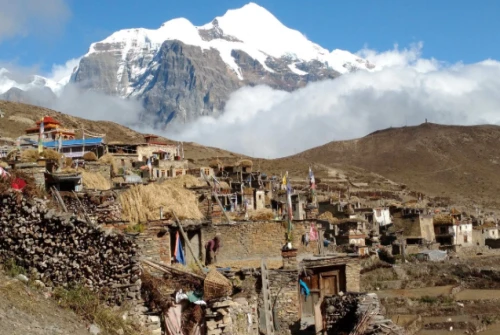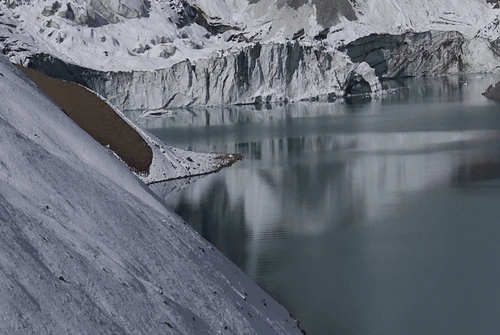Tsum Valley Trekking: 14-Day Adventure to the Hidden Beauty Near Mount Manaslu
The Tsum Valley Trek is a 14-day tea house trek that takes trekkers up close to the stunning Mount Manaslu (8,163m), the eighth-highest mountain in the world. The trek takes you through the hidden valley of Tsum, a restricted area that opened to trekkers in the early 90s, allowing you to experience a remote, untouched part of the Himalayas. This trek is known for its raw natural beauty and Tibetan culture, which remains well-preserved and largely undiscovered by the outside world.
Trek Overview
The Tsum Valley Trek is designed for trekkers with a moderate to good level of fitness. The trek includes daily walks of approximately 6 to 7 hours on rugged, sometimes snow-covered terrain. The trail ascends to altitudes above 3,000 meters, with the highest point being the Ngula Dhojhyang Pass at 5,093 meters, which is near the Tibetan border. While the trek doesn’t require crossing the high-altitude Larkya La Pass (5,160m), you will encounter a range of challenges, from rocky paths to high-altitude landscapes. The average daily hike takes you through remote villages, Buddhist monasteries, and ancient temples, making it a spiritual as well as a physical journey.
Tsum Valley Trek Route Overview
The Tsum Valley Trek begins with a scenic drive from Kathmandu to Machha Khola, marking the start of our exciting trekking adventure. From Machha Khola, we follow a well-defined trail along the Budi Gandaki River, which leads us through a series of traditional villages and terraced fields. As we ascend into the Tsum Valley, the landscape gradually transforms, offering breathtaking views of snow-capped peaks, deep gorges, and cascading waterfalls.
Our journey takes us through several quaint villages, starting with Machha Khola and Jagat, where we have the opportunity to experience the local culture and interact with the welcoming villagers. We continue our trek through the charming Philim village, which is famous for its rich Gurung heritage. From there, we move on to Chumling and Chhekampar, both of which are located within the mystical Tsum Valley.
The exploration of the Tsum Valley is a highlight of this trek, as it offers a peaceful and culturally rich experience. Here, we visit ancient Buddhist monasteries, including the famous Mu Gompa, which sits atop a hill, offering both religious significance and a tranquil space for reflection. These monasteries are not just spiritual landmarks but also provide a glimpse into the Tibetan Buddhist culture that has thrived in the valley for centuries.
After our time in the Tsum Valley, we retrace our steps and connect with the Manaslu Circuit Trail at Chumling. From this point, the trek takes us through lush forests, alpine meadows, and high mountain passes, providing us with more incredible views of the Himalayan ranges, including Manaslu, Ganesh Himal, and Himlung Himal.
This route offers a perfect blend of cultural discovery, spiritual exploration, and stunning natural beauty, making the Tsum Valley Trek an unforgettable experience.
Tsum Valley Trek Highlights
Stunning Mountain Views: The trek offers panoramic views of some of the highest peaks in Nepal, including Mount Manaslu, Ganesh Himal, Simrang Himal, Hiunchuli, and Larkya Peak. On a clear day, you can also witness views of Himlung Himal, Cheo Himal, and Kangguru from various points along the trail.
Rich Culture & Spirituality: The Tsum Valley, often referred to as the Hidden Valley, is rich in Tibetan Buddhist culture. Along the way, you will encounter numerous mani walls, chortens, and Buddhist temples. A key highlight is visiting Milarepa’s Cave, which is an important pilgrimage site for Tibetan Buddhists. You may also meet Buddhist monks and nuns during your trek.
Wildlife & Natural Beauty: The region is home to mountain birds like the Lophophorus, Nepal’s national bird. You'll also pass through dense forests, cross suspension bridges, and trek alongside roaring rivers and waterfalls. The rocky cliffside paths will challenge your stamina, but they also reward you with unforgettable views of snow-capped mountains and pristine landscapes.
Remote Villages & Terraced Fields: The trek passes through Gurung villages where locals still maintain traditional lifestyles, farming terraced rice fields and trading goods with Tibetan traders. The hospitality of the locals and the simple charm of the villages will make you feel welcome in this remote part of Nepal.
Tsum Valley Trek Distance, Duration, and Altitude
The Tsum Valley Trek is a rewarding journey that covers various distances and altitudes across remote and culturally rich landscapes. Below is a breakdown of the trekking route, distance in kilometers, estimated trekking duration in hours, and the altitude at each point along the trek:
| Day | Route | Distance | Duration | Altitude |
|---|---|---|---|---|
| Day 1 | Arrival Day | - | - | - |
| Day 2 | Trek Preparation | - | - | - |
| Day 3 | Kathmandu to Machhakhola | - | 7 hours | 900m |
| Day 4 | Machhakhola to Jagat | 15 km | 7 hours | 1500m |
| Day 5 | Jagat to Chumling | 17 km | 8 hours | 2385m |
| Day 6 | Chumling to Chhekangparo | 6.3 km | 5 hours | 3010m |
| Day 7 | Chhekangparo to Nile | 12 km | 5-6 hours | 3361m |
| Day 8 | Nile to Mu Gompa | 12 km | 3 hours | 3700m |
| Day 9 | Mu Gompa - Sightseeing | - | Full Day | 3700m |
| Day 10 | Mu Gompa to Burgi Village via Milarepa Cave | 12 km | 5 hours | 3245m |
| Day 11 | Burgi Village to Chumling | 15 km | 5-6 hours | 2386m |
| Day 12 | Chumling to Philim | 10 km | 6-7 hours | 1570m |
| Day 13 | Philim to Machhakhola | 15 km | 6-7 hours | 900m |
| Day 14 | Machhakhola to Kathmandu | 15 km | 7 hours | 700m |
Best Time to Trek the Tsum Valley
The best seasons to trek the Tsum Valley are spring (March-May) and autumn (Sept-Nov). In spring, the trails come alive with rhododendron flowers, fresh greenery, and moderate temperatures, making it one of the most pleasant times to trek. The weather during autumn is equally favorable, with clear blue skies, pleasant temperatures, and a stunning contrast of golden fields and snow-capped peaks. These seasons provide the best trekking conditions, with comfortable days and cool, crisp nights.
However, the monsoon season (June-August) and winter (December-February) are not ideal for trekking. The monsoon brings heavy rainfall, making trails slippery and potentially dangerous, while winter brings freezing temperatures, snow accumulation, and possible trail blockages. But if you’re looking for solitude and don't mind the cold, winter offers the advantage of fewer trekkers on the trail and stunning views of snow-covered peaks.
Accommodation and Food on the Tsum Valley Trek
During the 14-day trek, you will be staying in tea houses, simple lodges offering basic facilities but cozy rooms with comfortable beds, blankets, and pillows. The tea houses serve hearty meals to keep you energized for the trek. Expect a range of nutritious options, including dal bhat (lentil soup with rice), thukpa (noodle soup), momos (dumplings), roti tarkari (flatbread with vegetables), and eggs. There are also hot and cold drinks like tea, coffee, and hot chocolate available. At higher altitudes, the facilities may be more basic, but the hospitality of the locals makes the experience rewarding.
Trekking Difficulty & Preparation
The Tsum Valley Trek is moderately challenging and is suitable for trekkers who are in good physical shape. While it doesn't reach the extreme altitudes of other treks in Nepal, it does require stamina due to long daily walks and ascents. Those new to trekking should prepare by engaging in strength exercises, cardio workouts, and practicing hiking on uneven terrain. The trek includes days at high altitudes, so physical and mental fitness is essential to fully enjoy the experience.
Guides and Porters for Tsum Valley Trek
To ensure a smooth and enjoyable trek, you will be accompanied by a professional guide and a porter. The guide will not only lead you along the best routes but also share insights into the history, culture, and religion of the region. The porter will carry your heavy bags, leaving you to focus on the trek. Having both will make your journey more comfortable and safe, especially in the remote and challenging conditions of the Tsum Valley.
Trekking Permits for Tsum Valley
To trek in the Tsum Valley, you will need several trekking permits. These include:
Manaslu Conservation Area Permit (MCAP)
Trekkers’ Information Management System (TIMS) card
A special permit for Tsum Valley, which is issued by Nepal's Department of Immigration
These permits ensure that you are allowed to trek in this restricted area, helping protect its environment and local culture.
Why Choose the Tsum Valley Trek?
The Tsum Valley Trek offers trekkers the chance to experience a truly unique part of Nepal, with its remote villages, stunning mountain views, cultural richness, and spiritual significance. If you want to explore a place that feels like a hidden gem, the Tsum Valley provides an adventure that will stay with you forever. Whether you’re looking for peaceful solitude, breathtaking natural beauty, or a cultural journey, this trek offers it all.


 based on 6 reviews
based on 6 reviews
